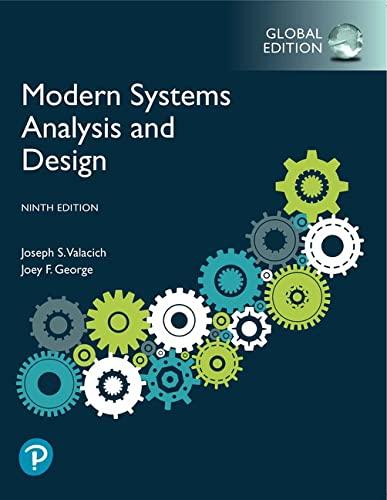Match each of the key terms above with the definition that best fits it. Maintenance ____ The
Question:
Match each of the key terms above with the definition that best fits it.
Maintenance
____ The complex organizational process whereby computerbased information systems are developed and maintained.
____ Computer software designed to support organizational functions or processes.
____ The organizational role most responsible for the analysis and design of information systems.
____ A standard process followed in an organization to conduct all the steps necessary to analyze, design, implement, and maintain information systems.
____ The traditional methodology used to develop, maintain, and replace information systems.
____ The first phase of the SDLC, in which an organization’s total information system needs are identified, analyzed, prioritized,
and arranged.
____ The second phase of the SDLC, in which system requirements are studied and structured.
____ The third phase of the SDLC, in which the description of the recommended solution is converted into logical and
then physical system specifications.
____ The part of the design phase of the SDLC in which all functional features of the system chosen for development are described independently of any computer platform.
____ The part of the design phase of the SDLC in which the logical specifications of the system from logical design are transformed into technology-specific details from which all programming and system construction can be accomplished.
____ The fourth phase of the SDLC, in which the information system is coded, tested, installed, and supported in the
organization.
____ The final phase of the SDLC, in which an information system is systematically repaired and improved.
____ Systems development methodologies and techniques based on objects rather than data or processes.
____ A structure that encapsulates (or packages) attributes and the methods that operate on those attributes. It is an abstraction of a real-world thing in which data and processes are placed together to model the structure and behavior of the realworld object.
____ The property that occurs when entity types or object classes are arranged in a hierarchy and each entity type or object
class assumes the attributes and methods of its ancestors—that is, those higher up in the hierarchy. The property allows new but related classes to be derived from existing classes.
____ A logical grouping of objects that have the same (or similar) attributes and behaviors (methods).
____ An object-oriented systems development methodology. This methodology establishes four phases of development, each
of which is organized into a number of separate iterations:
inception, elaboration, construction, and transition.
Step by Step Answer:

Modern Systems Analysis And Design
ISBN: 9781292351629
9th Global Edition
Authors: Joe Valacich, Joey George





